Buenos Aires Travel Guide
The capital and largest city in Argentina, Buenos Aires blends the laid-back ambience of a European capital with the fiery passion of a Latin-American barrio, a combination that makes it an irresistible travel destination. Home to roughly 40 percent of the country's population, this bustling metropolis is as cosmopolitan as it gets, with a diverse population energetic in its enthusiasm for enjoying city life.
Buenos Aires is consistently rated among the top holiday destinations in the world, and it's easy to see why. Visitors looking for a party will find countless pumping bars and nightclubs, with tango dancing spilling out into the streets; night owls can drink mate or dance into the early hours of the morning.
Buenos Aires is also the shopping capital of Argentina, with plenty of shopping malls and markets for buying souvenirs.
The local restaurants scene offers the best in Argentinean cuisine, which means succulent steaks are the specialty of most houses. Restaurants range from al paso (walk through) to fine dining, with plenty of small restaurants offering a range of cuisines representing the local immigrant communities. As Argentina is known for its excellent wine, visitors can take the time to sample the local varietals.
This coastal city offers no end of entertainment for all visitors, young and old. Passion combined with a sophisticated outlook makes Buenos Aires a travel destination that will not soon be forgotten.
Best time to visit Buenos Aires
Autumn (March to May) and spring (September to November) are good times to visit Buenos Aires, as the weather is ideal. Summer (December to February) tends to be crowded with tourists, though locals flee the city heat for the beaches and restaurants and museums have reduced hours. October and November is the best time to visit, as the purple jacaranda trees are in full bloom.
What to see in Buenos Aires
-Watch the street performers of La Boca and the Plaza Dorrego. -See the ostentatious Casa Rosada, former home of Juan and Eva Peron. -Wander around the elaborate monuments of La Recoleta Cemetery.
What to do in Buenos Aires
-Navigate Nueve de Julio Avenue, the widest street in the world. -Learn to tango in one of Buenos Aires' trendy nightclubs. -Take the kids to the Botanical Gardens. -Catch a polo match or take a lesson.
Beyond Buenos Aires
Buenos Aires is the gateway to Argentina, as most international flights land here. From Buenos Aires, travellers can spend the weekend at the fashionable beach resorts of Mar del Plata, 230 miles (400km) to the south. Many travellers head north to Cordoba and the rolling plains of the Pampas where the gauchos (cowboys) roam, and further north to the spectacular Iguazu Falls. Montevideo, across the border in Uruguay, is also accessible from Buenos Aires by ferry.
Getting there
Ezeiza Ministro Pistarini International Airport is located 14 miles (22km) southwest of Buenos Aires, and is connected to the city via shuttles, taxis, and buses. Direct flights to Buenos Aires are available from a number of cities worldwide, including London, Miami, Santiago de Chile, Istanbul and Moscow.
Did you know?
-The Spanish spoken in Buenos Aires is coloured with local slang called Lunfardo, and differs from that spoken in other parts of the country.
-The standard greeting in Buenos Aires is a kiss on the cheek, whether male or female.
-Buenos Aires has the second largest Jewish population (over 300,000) in the Americas, second only to New York City.
Things to do in Buenos Aires
Meaning 'fair winds' in Spanish, Buenos Aires has several enthralling attractions. Most sightseeing is best done by day, for aesthetic and safety purposes, and walking is the best but by no means only mode of transport in this intriguing city.
Travellers can visit the Cementerio de la Recoleta, home to the tomb of Eva Peron, the actress who married Argentina's President Juan Peron and is the subject of the musical Evita, or wander under the magnificent facades of the downtown area, particularly enjoyed for its marvellous old European buildings. Enthusiastic sightseers can take a paddleboat from the promenade in Palermo and stroll through the beautiful flower garden.
An absolute must for those refined travellers of culture is a trip to the Palermo Viejo district, with its charming cobblestone streets, bookstores, bars and boutiques. Another must would be an afternoon spent exploring the Caminito pedestrian street's arts and crafts in La Boca or a visit to the National Immigration Museum for a taste of history. Many enjoy watching tango dancers in the cobblestone streets and taking a tour of the La Bombonera Stadium.
Visitors wanting to catch a show can do so at the Recoleta Cultural Center. Built in 1732, it was originally a convent connected to the Basílica del Pilar. Today it is a cultural centre hosting concerts, live performances and screenings. The historical building also houses sculptures, paintings and photographs in different exhibitions, providing a fantastic sightseeing experience for any visitor to this exciting city.
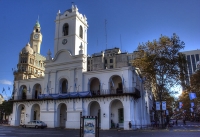
Cabildo
Sitting opposite the Casa Rosada on the Plaza de Mayo, the Cabildo is an old colonial building fronted by rows of breathtaking arches. Construction began in 1610 and ended in 1894, with the interior housing museums dedicated to its illustrious past and boasting relics, religious icons and paintings by Enrique Pellegrini. The changing of the guard is a popular attraction, with the troops being members of the revered Regimiento de Patricios and dressed in traditional uniforms unchanged for nearly 200 years. Craft markets are hosted on the back patio on Thursdays and Fridays, from 11am to 6pm.
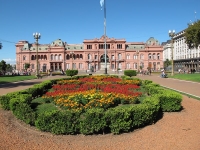
Casa Rosada
The famous Casa Rosada is iconic, rousing images of fiery political rallies or the tragic romance of Eva Peron. The Italianate-style mansion is fronted by palm trees and fountains, its edifice painted pink when it was converted into a presidential palace. The building has since been declared a National Historic Monument of Argentina. Today, the building houses a small basement museum, and each evening, a small platoon of mounted grenadiers emerges from the guardhouse to lower the flag on the plaza, adding a touch of pomp and ceremony to the striking building.
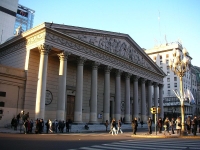
Cathedral Metropolitana
Situated in the Plaza de Mayo, the neoclassical Cathedral Metropolitana houses the tomb of General Jose de San Martin, the revered hero who liberated Argentina from the Spanish. The mausoleum is guarded by three sculptures, each a life-size female figure representing Argentina, Chile and Peru. It also contains the remains of General Las Heras, General Tomas Guido and the Unknown Soldier of the Independence. The cathedral has been periodically rebuilt and renovated since the 16th century, its gilded columns, Venetian mosaic floors and silver-plated altar in pristine condition. Some interesting things to see in the cathedral are the two pulpits, a wide variety of colonial sculptures and paintings, and the 1871 Walcker Organ, one of the finest examples of its kind.
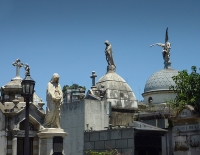
La Recoleta Cemetery
An unlikely tourist attraction, La Recoleta Cemetery is well worth visiting to see its magnificent display of monuments and the ostentatious tombs of Argentina's rich and famous. The cemetery is the second largest in the world, covering more than five hectares and filled with more than 4,700 vaults. Each vault has the family name carved over its entrance, while a collection of brass plaques next to the entrance displays the names of all the family members buried inside the vault. One of the more modest but most celebrated is the grave of Eva Peron, where thousands leave flowers. Another famous cemetery inhabitant is the supposed daughter of Earl Alexander Walewski, Isabel, who died in Buenos Aires when just a baby. The superstitious say that on some nights, you can hear the baby crying from her godmother's arms.
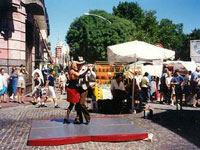
Plaza Dorrego
Plaza Dorrego lies in San Telmo, the bohemian artists' quarter of Buenos Aires and the birthplace of tango. The tiny square is surrounded by elegant houses, now mostly converted into antique shops and bars whose tables overflow onto the street. There are numerous excellent museums nearby, including the Museo Historico Nacional and the Museo de Arte Moderno. On Sundays, the plaza hosts the Feria de San Telmo. Visitors won't find too many bargains, but they may find an interesting souvenir or two. Once the stallholders pack up their wares, the square becomes a stage for informal tango dancing, popular with locals and tourists alike.
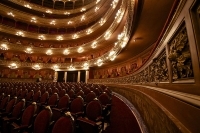
Teatro Colon
The Teatro Colon opened in 1908 and is one of the largest performing arts theatres in the southern hemisphere, second only to the Sydney Opera House in Australia. It was designed by Italian architect Francisco Tamburri and is an Italian Renaissance-style building with seating for 2,500. Richly decorated in scarlet and gold with frescoes lining the cupola, the theatre has hosted many international performers, including Nijinsky, Pavarotti and Domingo, and is considered to be among the top five venues for acoustics in the world, an opinion voiced by Pavarotti among others. The theatre is also home to the Superior Arts Institution of the Teatro Colon, and guided tours take visitors to the theatre's workshops, rehearsal rooms, auditorium and stage.
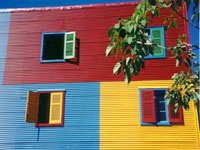
La Boca
Situated in the south-east of Buenos Aires at the mouth of the Riachuelo River, La Boca is the most colourful neighbourhood or barrio in Buenos Aires, original home of both football legend Maradona and the tango. An assortment of brightly painted houses made of wood and metal line streets of artisans, painters, street performers, cantinas and open-air tango shows. Originally settled by Genoese immigrants, it's now a veritable melting pot of cultures and people. Today it is frequented by crowds of tourists who come to soak up the lively atmosphere and sit in picturesque cafes sipping coffee and beer. Some places of particular interest in La Boca are La Ribera theatre, and La Bombonera, the home of the famous Boca Juniors football club.
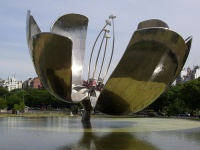
Floralis Generica
Located in the leafy suburb of Recoleta, Floralis Generica is a unique steel and aluminium flower sculpture that was offered to the city by Argentine architect Eduardo Fernando Catalano. The 76-foot-high (23m) structure is meant to open at dawn and close at dusk, when the setting sun turns its mirrored surfaces a glowing pink, but it's been stuck in open mode for several years because of a faulty petal that no-one can afford to fix. It sits above a reflecting pond, and the area around it has been landscaped to resemble woodlands. The sheer genius and technical artistry of the giant flower make it a sight worth seeing.
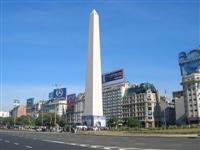
Nueve de Julio Avenue
At 416 feet (127m) wide, spanning the width of an entire city block, Avenida 9 de Julio is claimed to be the widest avenue in the world. Named for Argentina's Independence Day, which falls on 9 July, the avenue was only completed in the 1960s, some 70 years after its original planning. The avenue runs from the Retiro district in the north to Constitucion station in the south, roughly one kilometre to the west of the Rio de la Plata waterfront, and consists of 18 lanes of traffic, nine on each side. In the middle of the street stands the impressive 67-metre-tall obelisk marking the heart of Buenos Aires.
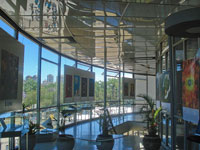
Galileo Galilei Planetarium
The Galileo Galilei Planetarium is located inside the Bosques de Palermo, its massive dome making it almost impossible to miss for those who love the stars. The building is made up of six floors, five staircases and a main room with a 60-foot (20m) diameter, filled with 360 seats. On any given day, this planetarium is abuzz with the chatter of children enjoying a spot of stargazing. The planetarium regularly changes its shows and displays, which include First Man in Space, A Blue Planet, and Super Moons. In addition to the main show, there is also a small museum containing a lunar rock, a collection of 100-million-year-old sea life fossils and a metallic meteorite from Chaco Province.
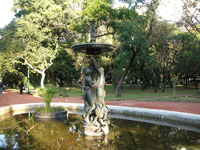
Buenos Aires Botanical Gardens
Lined with trees, flowers and other indigenous plants, the Buenos Aires Botanical Gardens are a great place to take the kids. Open since 1898, the grounds contain a symmetric Roman garden, a picturesque Oriental garden and a mixed French garden. With plenty of open space, hundreds of stray yet friendly cats and a fascinating greenhouse for inquisitive kids, it's the ideal location to relax with a picnic or take a leisurely walk with the family. Its 33 sculptures and monuments, along with a botanical library, are also open to the public.
Things to do with kids in Buenos Aires
For many children travelling in Buenos Aires, the chaos of the city can be quite intimidating. However, parents don't need to fret as there are great child-friendly attractions tucked away in just about every barrio (neighbourhood).
Buenos Aires is a great city to explore on foot but, for the more active, it is also extremely bicycle-friendly. Travellers can rent a bike and pedal their way round the leafy suburbs and side streets. They can also stop off at the Nueve de Julio Avenue, the widest avenue in the world and admire the 220-foot-tall (67metre) obelisk in the centre, marking the heart of Buenos Aires. Or for a slightly more cultural experience, a stroll with the children past the Floralis Genérica in Recoleta, a working metal sculpture of a flower that opens and closes with the sun, is highly recommended.
For those days when the sun isn't shining, visitors should head to one of the many indoor playgrounds or museums dotted around the city, such as the Museo de Los Ninos or the Galileo Galilei Planetarium, where children will have a great time stargazing and learning about the solar system.

Galileo Galilei Planetarium
The Galileo Galilei Planetarium is located inside the Bosques de Palermo, its massive dome making it almost impossible to miss for those who love the stars. The building is made up of six floors, five staircases and a main room with a 60-foot (20m) diameter, filled with 360 seats. On any given day, this planetarium is abuzz with the chatter of children enjoying a spot of stargazing. The planetarium regularly changes its shows and displays, which include First Man in Space, A Blue Planet, and Super Moons. In addition to the main show, there is also a small museum containing a lunar rock, a collection of 100-million-year-old sea life fossils and a metallic meteorite from Chaco Province.

Buenos Aires Botanical Gardens
Lined with trees, flowers and other indigenous plants, the Buenos Aires Botanical Gardens are a great place to take the kids. Open since 1898, the grounds contain a symmetric Roman garden, a picturesque Oriental garden and a mixed French garden. With plenty of open space, hundreds of stray yet friendly cats and a fascinating greenhouse for inquisitive kids, it's the ideal location to relax with a picnic or take a leisurely walk with the family. Its 33 sculptures and monuments, along with a botanical library, are also open to the public.
Eating Out
Beef is king in the Buenos Aires food world; Argentina is famous for the juiciest and most tender steaks, served in its (steak houses). Foodies can also enjoy various Spanish and Italian pleasures, as well as sushi, fusion, and vegetarian cuisine.
There are numerous (walk through) places in the city, selling (hot-dogs), (beef sausages) and (breaded, fried cutlets). Travellers can buy a , the most traditional non-alcoholic beverage, in any Coto or Carrefour supermarket. Visitors should try the gourmet (ice cream) and (small pastries stuffed with combinations of cheese and meats), or the , an Argentinean cookie.
Various small restaurants offer foreign meals, mostly Japanese, Chinese, Thai, Arabic, Spanish and Italian. Expensive and luxurious restaurants can be enjoyed at Puerto Madero and Palermo. The main areas to go out are Puerto Madero, Recoleta, Palermo SoHo and Palermo Hollywood, home to trendy stores, restaurants and bars. Most locals head out to dinner around 9pm.
Shopping
Buenos Aires offers a wealth of authentic local treasures, from fine leather goods found in Murillo Street to alfajores, the traditional cakes and cookies often containing dulce de leche. Popular Buenos Aires souvenirs include tango music, mate cups, leather goods and Argentine wine. Shops are generally open Monday through Friday from 9am to 8pm, and Saturdays from 9am to 1pm.
Florida Street and Lavalle Street are for pedestrians only. In the zona de calzados there are many shops that sell tango shoes, and the Palermo Viejo in Palermo has various shops that will appeal to the young and artsy. There are also numerous fairs and markets to be explored, including Recoleta Fair and the San Telmo market.
Feria Recoleta, in Plaza Francia, boasts an assortment of artisan goods. Travellers can take in the Plaza Serrano in Palermo Viejo and the Plaza Dorrego in San Telmo. Defensa Street entices visitors as it comes alive with performers and vendors. Funky candles, street address plates and markers are available from Último Taller.
Shopping malls are a regular attraction and convenient shopping locations for many portenos (people from the port). The most famous stores in Buenos Aires can be found in these vast malls, along with restaurants, cafes, arcades and movie theatres. Shopping malls are open 7 days a week from 10am to 10pm.
Nightlife
Famed for its huge selection of trendy clubs, fashionable music bars and attractive restaurants, it's no wonder the city of Buenos Aires never sleeps. From the dimly lit tango bars and mainstream hard house dance clubs to the Teatro Colon and smaller independent theatres, there is something for just about everyone in this buzzing city.
In typical Latin fashion, dinner is eaten late, usually between 10pm and 11pm, so clubs only really get going at around 2am. Puerto Madero, near the Casa Rosada, is popular with tourists and expats and is considered safe during the day and at night. Recoleta, Palermo, and San Telmo are the trendiest neighbourhoods for dance clubs and all the hippest locals can be found sipping on long drinks in the surrounding bars. It is not uncommon to find residents walking home at sunrise after a big night out on the town.
Culture vultures will simply adore the arts and culture scene here, and plenty of Broadway-style hits can be found in both English and Spanish at most of the 30-odd professional and underground theatres in the San Telmo and Abasto neighbourhoods.
Other than the run-of the-mill watering holes, there are also many bars in Buenos Aires offering live acoustic music or displays of flamenco dancing, readings, tango and folkloric dance, providing a bit of entertainment to accompany evening drinks. The gay scene in Buenos Aires is thriving and rivals only that of Rio de Janeiro's in South America, with San Telmo being the main strip catering to this market.
Getting Around
The street structure, organised in a grid pattern, makes it easy to get around in Buenos Aires, and the best way to explore the city and take in its character is on foot. However, the city is serviced by an efficient, widespread and cheap public transport system that consists of buses and an excellent underground rail service (the Subte). Although it services most of the city centre, the Subte is not very extensive beyond the central core. The Subte is cost effective since it is charged per journey and not dependent on the distance travelled. Pre-paid Subte cards or passes can be purchased from the ticket booths ( ) at each station. It gets very hot and crowded in summer especially during peak hours, and closes between 11pm and 5am.
The bus network is huge and covers the city, and although very useful for getting around, the overwhelming number of routes make it confusing for tourists. Bus fares are paid in coins into an automatic ticket vending machine when boarding the bus. Many services run all night but with less frequency. There are also urban train services that can be useful for reaching the outlying suburbs.
SUBE cards can be purchased at countless kiosks, shops and post offices throughout the city, which unify the bus and Subte services and reduce the cost of bus journeys. It is the most convenient means of payment.
Taxis are everywhere and are relatively inexpensive. Although generally safe, visitors should be aware that there are fake taxis that pick up tourists and rob them. It is safer to phone for a radio taxi or remis, a fixed-price radio cab booked in advance that acts like a chauffeur-driven car and can be cheaper than taxis over longer distances. They are often more useful than renting a car for excursions from the city and even for a day's tour of the suburbs. Ride-hailing apps include Uber and Cabify.
Buenos Aires Climate and Weather
Buenos Aires has a humid subtropical climate with average temperatures ranging from 84F (29C) highs in summer (December to February) to less than 50F (10C) lows in winter (July to August). The heaviest rain falls during summer, early autumn and late spring, though rain can be expected at any time of the year. Many locals leave Buenos Aires during the hot summer months (December, January and February) and head for the coastal resorts.
Argentina travel info
Electricity
Electrical current in Argentina is 220 volts, 50Hz. Most hotels and offices use the three-pin flat plug, though most older buildings use the two-pin round plug.
Language
Spanish is the official language of Argentina but English is generally understood in the tourist areas.
Money
The unit of currency is the Argentinean peso (ARS). Currency can be exchanged at banks and cambios (bureaux de change) but it is easier to use ATMs, available in most towns, which reflect the current exchange rate. Major credit and debit cards are generally accepted, and US dollars can be used in many tourist establishments.
Tipping
A 10 percent tip is expected at restaurants in Argentina. Porters expect some small change per bag.
Health
There are no major health risks in Argentina, except potential mosquito-borne viruses in the northern regions of the country. However, the risks are still fairly minimal and common safety precautions should provide enough protection. All eligible travellers should be up to date with their COVID-19 vaccines. Medical facilities are good in the major cities, though treatment is expensive and medical insurance is advised. Asthma, sinus and bronchial ailments can be aggravated by pollution in Buenos Aires. Those with specific conditions should bring a sufficient quantity of medical supplies and medication for the trip.
Safety
There is no specific threat to foreigners and travellers should not be discouraged from travelling throughout the country. However, it's best to be aware of bag-snatchers, pickpockets and con men, particularly in crowded areas in Buenos Aires, on public transport and in popular tourist haunts, such as San Telmo.
Local customs
Argentineans are warm and unreserved people. Both men and women greet each other by kissing on the cheek, and will often touch each other when speaking and maintain little physical distance between speakers. With its origins in the working-class neighbourhoods of Buenos Aires, tango lives on today as a cultural pillar of Argentinean society. Likewise, football in the country is almost like a religion and is a hugely significant part of its cultural identity.
Doing business
Business people dress well in Argentina and visitors are expected to wear a smart suit. Handshaking is normal. Argentineans are great conversationalists and are interested and knowledgeable about world events, politics and sports. Meetings usually begin with small talk and it's important to use titles when addressing people, the form being Senor (Mr), Senora (Mrs) and Senorita (Miss) followed by their surname.
Business culture in Argentina can be bureaucratic and, as with most South American countries, negotiation and decision making can take a long time and is best done face to face. Foreigners should make sure they see the right people, as only those in high positions are likely to be able to make a final decision. Business hours are 9am to 5pm in Buenos Aires, with an hour for lunch. Outside the capital, it is normal to take a siesta between 1pm and 4pm. Many business people are away on holiday during January and February.
Duty free
Travellers to Argentina over the age of 18 years can bring in the following items to the value of US$300 without incurring customs duty: two litres of alcohol, 400 cigarettes or 50 cigars, and 5kg of food items. Restrictions apply to fresh foodstuffs such as meat and dairy products. Prohibited items include explosives, flammable items, narcotics and pornographic material. Firearms and ammunition for sporting purposes are allowed if accompanied by a license or certificate.
Communications
The international access code for Argentina is +54. Mobile roaming charges can be expensive; prepaid local SIM cards are available for purchase on arrival and are a good alternative. Free WiFi is offered at most restaurants, cafes and hotels in tourist centred areas of the country.
Passport & Visa
Valid passports are required for travel to Argentina. Visas are not generally required for stays of less than three months, with the possibility of an extension of stay. It is recommended that all visitors have sufficient funds, as well as onward or return tickets and documents required for next destination. It is highly recommended that travellers' passports have at least six months' validity remaining after the intended date of departure from their travel destination. Immigration officials often apply different rules to those stated by travel agents and official sources.
Entry requirements
US nationals require a passport that is valid at the time of entry, but no visa is required for stays of up to 90 days.
UK nationals require a passport that is valid for the duration of their stay, but no visa is required for a stay of up to 90 days.
Canadians require a passport that is valid for the duration of their stay, but no visa is required for a stay of up to 90 days.
Australians require a passport that is valid for the duration of their stay, but no visa is required for a stay of up to 90 days.
South African nationals must hold a valid passport, but no visa is required for a maximum stay of up to 90 days.
Irish nationals require a valid passport, but no visa is required for a stay of up to 90 days.
New Zealand nationals require a valid passport, but no visa is required for stays of up to 90 days.
Useful contacts
National Secretariat of Tourism, Buenos Aires: +54 (0)11 4316 1600 or www.turismo.gov.ar
Emergencies: 101 (police), 107 (medical emergencies), 100 (fire), 911 for English language service in Buenos Aires only.Embassies / consulates in other countries
Embassy of Argentina, Washington DC, United States: +1 202 238 6400.
Embassy of Argentina, London, United Kingdom: +44 207 318 1300.
Embassy of Argentina, Ottawa, Canada: +1 613 236 2351.
Embassy of Argentina, Canberra, Australia: +61 2 6273 9111.
Embassy of Argentina, Pretoria, South Africa: +27 (0)12 430 3524/7.
Embassy of Argentina, Dublin, Ireland: +353 (0)1 269 1546.
Embassy of Argentina, Wellington, New Zealand: +64 (0)4 472 8330.
Embassies / consulates in Argentina
United States Embassy, Buenos Aires: +54 (0)11 5777 4533.
British Embassy, Buenos Aires: +54 (0)11 4808 2200.
Canadian Embassy, Buenos Aires: +54 (0)11 4808 1000.
Australian Embassy, Buenos Aires: +54 (0)11 4779 3500.
Embassy of South Africa, Buenos Aires: +54 (0)11 4317 2900.
Embassy of Ireland, Buenos Aires: +54 (0)11 5787 0801.
New Zealand Embassy, Buenos Aires: +54 11 5070 0700.



